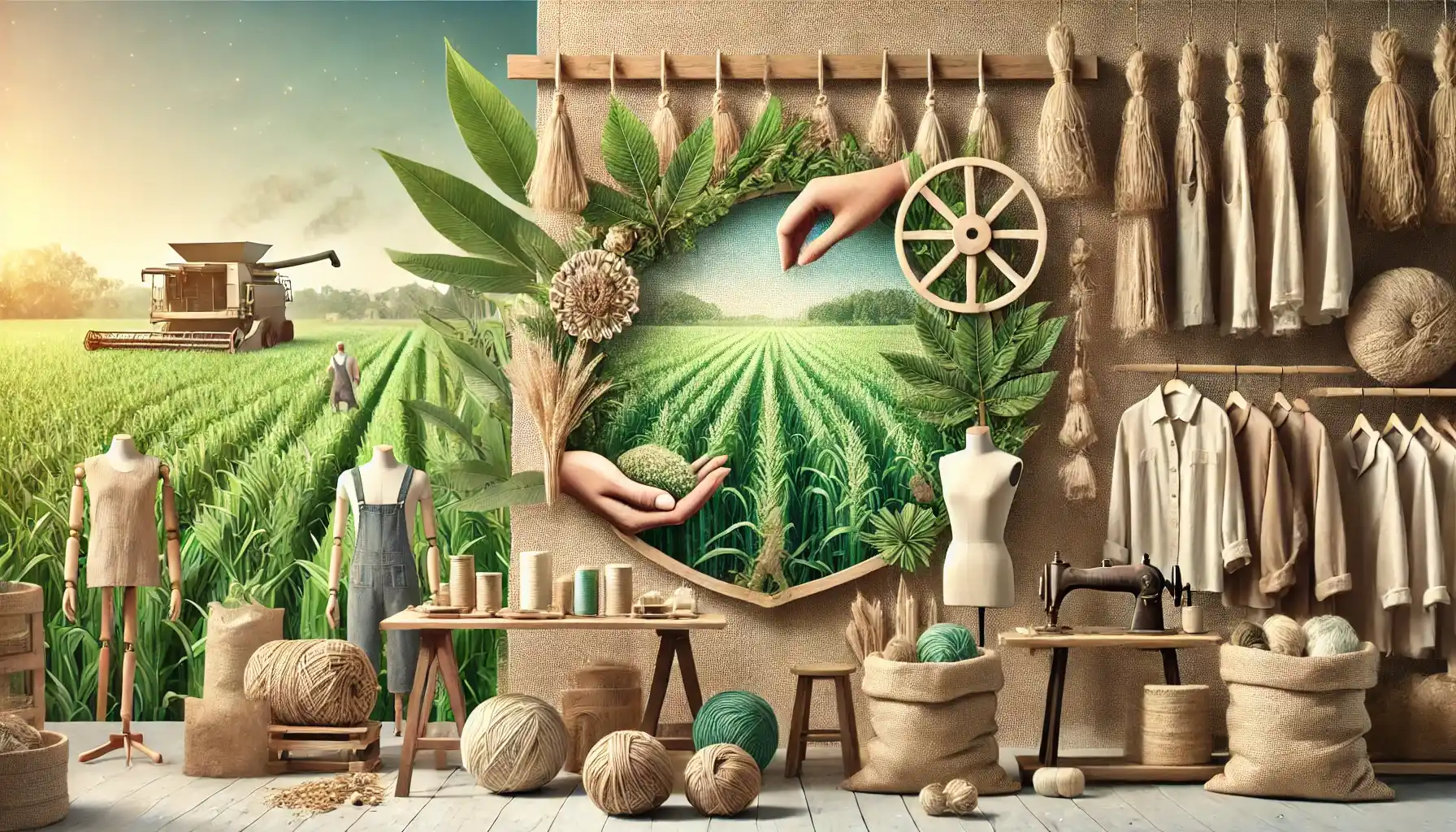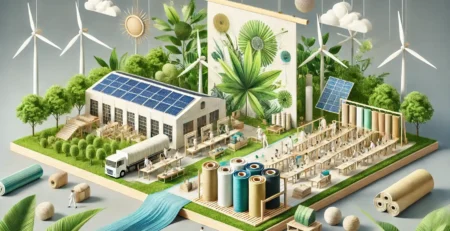
12
Mar
How Sustainable Materials Like Jute and Hemp Are Revolutionizing the Textile Industry
The textile industry is undergoing a transformation as sustainability takes center stage. With growing concerns about environmental impact, pollution, and ethical labor practices, eco-friendly materials like jute and hemp are emerging as game-changers in sustainable fashion and packaging solutions.
Jute and hemp are natural, biodegradable, and renewable fibers that offer numerous advantages over synthetic materials. From custom jute bag suppliers for eco-friendly brands to sustainable jute bag exporters, businesses worldwide are shifting towards these environmentally friendly alternatives.
The Need for Sustainable Materials in the Textile Industry
The conventional textile industry is one of the largest polluters in the world, contributing to:
- Massive water consumption (especially in cotton farming)
- Toxic chemical pollution from dyes and synthetic fibers
- Microplastic contamination due to polyester-based textiles
- Deforestation and habitat destruction for fiber production
Sustainable materials like jute and hemp provide eco-friendly alternatives that help reduce environmental damage while promoting ethical and responsible sourcing.
Jute: The Golden Fiber of Sustainability
What is Jute?
Jute is a natural vegetable fiber primarily grown in India and Bangladesh. It is known as the “golden fiber” due to its golden-brown color and eco-friendly properties. Unlike synthetic materials, jute is:
✔ 100% biodegradable and compostable
✔ Highly durable and strong
✔ Grown with minimal pesticides and fertilizers
✔ Requires very little water for cultivation
These qualities make jute a preferred choice for sustainable fashion, eco-friendly bags, and home textiles.
Applications of Jute in the Textile Industry
Jute is widely used for various eco-friendly products, including:
- Jute Bags: Many brands are collaborating with custom jute bag suppliers for eco-friendly brands to create reusable shopping and promotional bags.
- Home Furnishings: Rugs, curtains, and cushions made from jute add a natural, rustic touch to interiors.
- Sustainable Packaging: Jute sacks and bags are replacing plastic packaging in industries like agriculture and retail.
Why Brands Are Choosing Jute for Sustainable Packaging
With increasing regulations on plastic reduction, businesses are opting for jute-based alternatives. Sustainable jute bag exporters are supplying eco-friendly bags to companies worldwide, helping them meet sustainability goals while reducing plastic waste.
Hemp: A Versatile and Eco-Friendly Fiber
What is Hemp?
Hemp is a fast-growing, sustainable crop known for its strength, durability, and eco-friendly properties. Unlike cotton, which requires heavy pesticide use and excessive water, hemp:
✔ Grows quickly with minimal resources
✔ Improves soil health and prevents erosion
✔ Requires less water than cotton
✔ Absorbs more carbon dioxide than trees
Applications of Hemp in Textiles
Hemp is revolutionizing the fashion industry, with designers incorporating it into:
- Hemp Clothing: Shirts, jeans, and dresses made from hemp fabric are breathable, antibacterial, and long-lasting.
- Eco-Friendly Accessories: Handbags, shoes, and belts crafted from hemp provide sustainable fashion alternatives.
- Hemp-Based Industrial Textiles: Used in ropes, tarps, and upholstery for durability and sustainability.
Why Hemp is a Better Alternative to Cotton
Hemp outperforms cotton in sustainability because:
- It produces 2-3 times more fiber per acre than cotton.
- It requires no synthetic fertilizers or pesticides.
- It is stronger and more durable, lasting longer than cotton textiles.
With these advantages, hemp is becoming a preferred material for eco-conscious fashion brands.
Jute vs. Hemp: A Comparison
| Feature | Jute | Hemp |
|---|---|---|
| Growth Rate | 4-6 months | 3-4 months |
| Water Requirement | Low | Very low |
| Pesticide Usage | Minimal | Almost none |
| Durability | Moderate | Very high |
| Biodegradability | 100% | 100% |
| Common Uses | Bags, rugs, ropes, packaging | Clothing, accessories, industrial textiles |
Both jute and hemp are sustainable choices, but hemp is better suited for fashion due to its durability, while jute is ideal for packaging and home textiles.
How Jute and Hemp Are Transforming the Fashion Industry
1. Reducing Waste and Pollution
Jute and hemp are biodegradable, meaning they decompose naturally without harming the environment. Unlike polyester and nylon, which contribute to microplastic pollution, these fibers leave zero toxic residue.
2. Supporting Ethical Labor Practices
The production of jute and hemp:
✔ Supports small-scale farmers
✔ Provides fair wages in rural communities
✔ Promotes ethical manufacturing
Many sustainable jute bag exporters work with fair-trade organizations to ensure ethical sourcing.
3. Encouraging Circular Fashion
Circular fashion focuses on:
- Recyclability: Jute and hemp products can be reused and composted.
- Durability: Their strength ensures longer product life cycles, reducing waste.
- Minimal waste production: Every part of the plant is utilized, from fibers to seeds.
4. Meeting Consumer Demand for Eco-Friendly Products
Consumers are actively looking for sustainable alternatives, and brands that switch to jute and hemp gain:
- A stronger brand reputation
- Loyalty from eco-conscious shoppers
- Compliance with sustainability regulations
The Future of Jute and Hemp in the Textile Industry
The demand for eco-friendly materials is growing, and industries worldwide are adopting jute and hemp for sustainable solutions. Government policies are also pushing for plastic-free packaging, boosting the market for custom jute bag suppliers for eco-friendly brands.
With ongoing research and innovations, jute and hemp fabrics are being enhanced for better softness, strength, and color retention, making them more versatile for future applications.
FAQs About Jute and Hemp in the Textile Industry
1.Why are jute and hemp considered sustainable?
Both fibers are biodegradable, require minimal resources, and do not contribute to pollution, making them eco-friendly alternatives.
2.What are the main uses of jute in textiles?
Jute is used for bags, rugs, ropes, and packaging solutions due to its strength and biodegradable nature.
3.How does hemp compare to cotton in sustainability?
Hemp requires less water, grows faster, and is more durable than cotton, making it a superior sustainable fabric.
4.Are hemp clothes comfortable to wear?
Yes, hemp fabric is breathable, lightweight, and softens over time, making it comfortable for daily wear.
5.Can jute bags replace plastic bags completely?
Yes, jute bags are reusable, biodegradable, and durable, making them a perfect alternative to plastic bags.
6.What are the benefits of using custom jute bag suppliers for eco-friendly brands?
Brands can get custom-designed, sustainable bags that align with their environmental goals and branding strategies.
7.How do sustainable jute bag exporters contribute to global markets?
They supply eco-friendly jute bags to businesses worldwide, helping reduce plastic waste and promote green alternatives.
8.Can hemp be blended with other fabrics?
Yes, hemp is often blended with cotton or silk to enhance softness and flexibility while maintaining sustainability.
9.Are jute and hemp textiles expensive?
While slightly more expensive than synthetic alternatives, they are cost-effective in the long run due to durability and reusability.
10.What is the future of jute and hemp in fashion?
With increasing consumer demand for sustainable textiles, jute and hemp are expected to dominate the eco-friendly fashion industry in the coming years.
Jute and hemp are revolutionizing the textile industry by offering sustainable, durable, and ethical alternatives to synthetic materials. From custom jute bag suppliers for eco-friendly brands to sustainable jute bag exporters, businesses worldwide are embracing these natural fibers to reduce environmental impact and meet consumer demand for sustainability.




